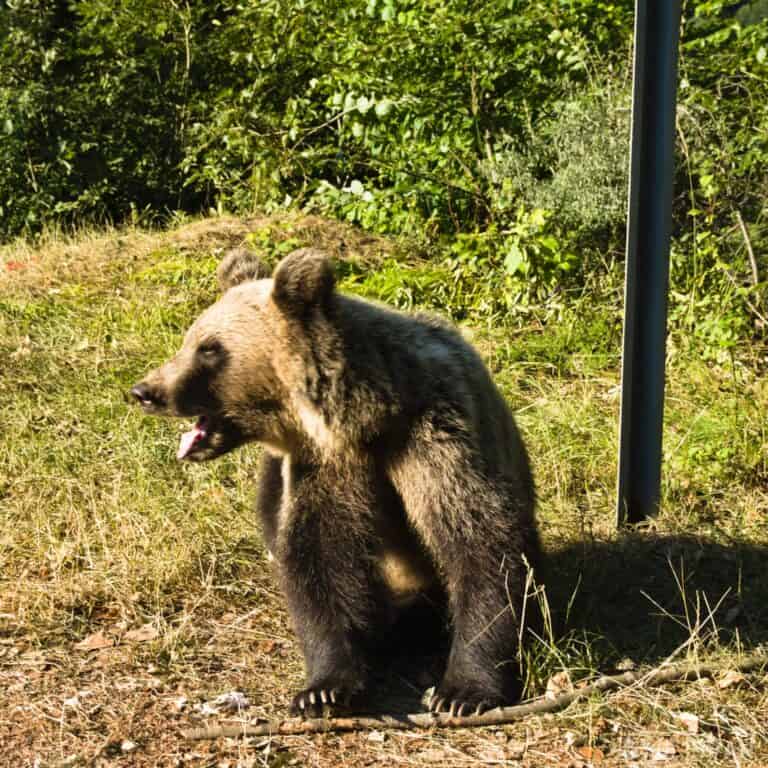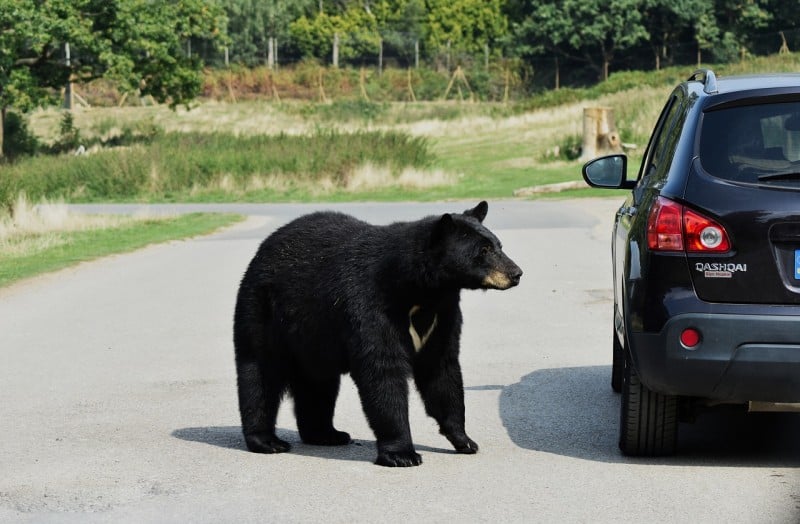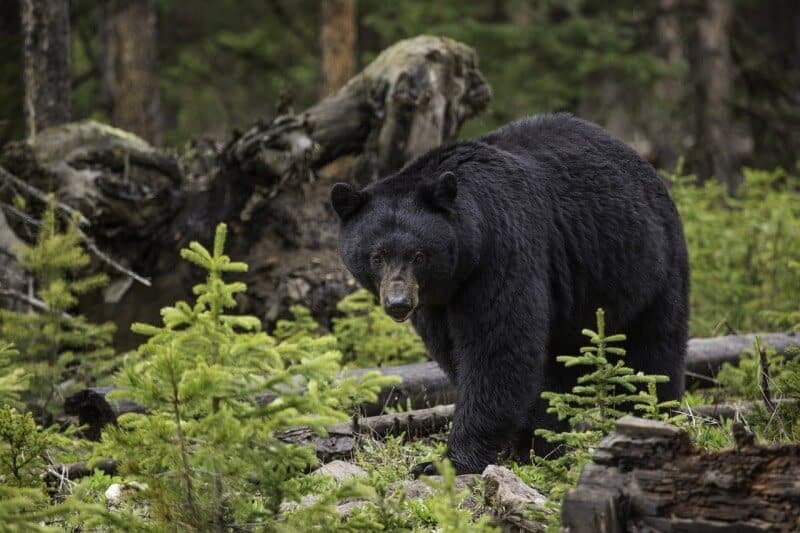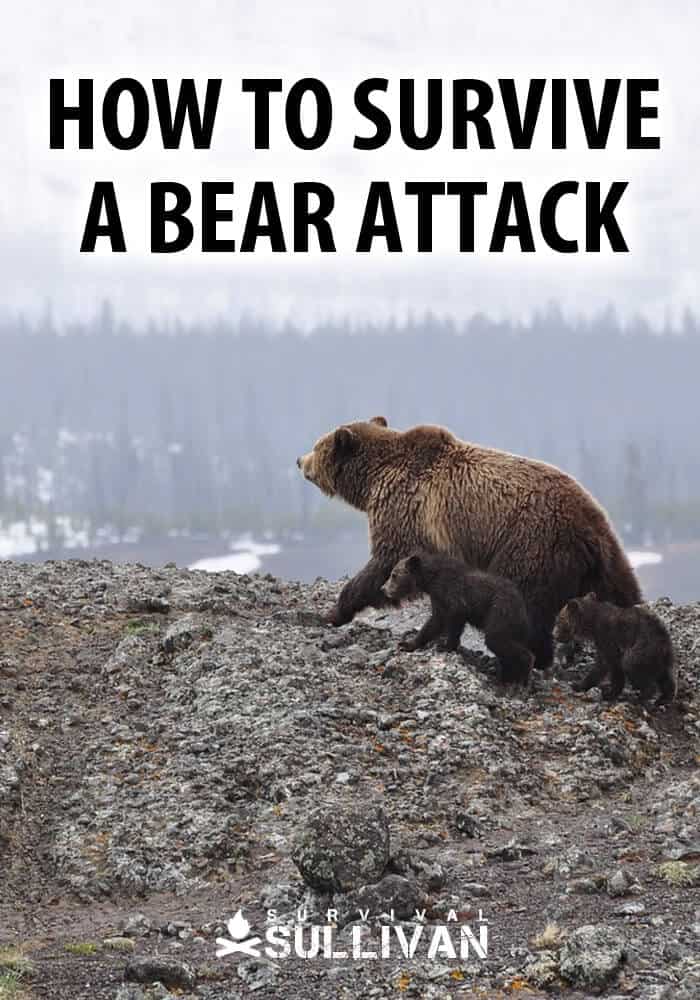Bears are among the largest and most plentiful mammalian predators on Earth, gifted with excellent senses and also quite a bit of curiosity. While bear attacks are rare, bears can be surprisingly common depending on your locale.

The overwhelming majority of bear encounters end with the bear scooting off to get away from the human, but this is not a certainty, and sometimes encounters turn violent.
A ticked-off bear can result from a number of things: surprising it, disturbing meal time, coming between a mother (sow) bear and her cubs or being the closest potential food source to a starving bear for starters. No matter the reason, you had better know how to stop the attack or, at worst, increase your chances of surviving it.
In this article, we’ll be examining in depth information on all three major North American bear species, their habits, their habitats, physiology and more to give you the information you need to avoid having a run-in with them, and should that occur, deal with an attack.
Table of Contents
Men are Created Equal, but Bears Aren’t
Most of us will be familiar with the two most common bear species in North America, the American Black Bear, and the Brown or Grizzly Bear. What you might not know, depending on how sharp your bear lore is, is just how different these species are.
From diet and dwelling to size and aggression, there are many variations between the bear species. Far from an interesting investigation into the animal kingdom, knowing what kind of bear you are dealing with is crucial, as without that, you may apply the wrong tactic in an effort to avoid the bear or survive a close-up encounter with it.
Luckily, the bear species are easy enough to tell apart, predominately by habitat but also by size. In the interest of making this guide easy to read, these chunky ursids will be given their own section so you can learn about them in total.
The Basics
Bear attacks are extremely rare no matter where you are and what you are doing, but naturally some activities and certain areas rich with bears will drastically increase your chances of encountering one of these ponderous beasts.
If you are anywhere in Yellowstone National Park, for instance, or a part of the mountain country in the Carolinas or east Tennessee, you will have a much greater chance of encountering a bear.
At any rate, thanks to conservation efforts bear populations are exploding all over North America, so no matter where you go, the bear population will be denser than in recent years past.
Hunting, fishing, hiking, camping and other similar activities that will take you deep into the wilderness and also set you after what a bear considers food will drastically bump your chances of attracting or encountering a bear.
Even if you live in suburbia there is no freedom from bears; black bears are notorious scavengers and opportunists, and are a frequent sight at dumpsters, pools and other fixtures of civilized life.
Dumpsters are food sources, pools keep bears cool and entertained (they swim for fun) and, being very curious, there is no telling where else they may wind up.
A few poor souls have reported a black bear, somehow, getting itself locked inside their car!

No matter the situation, no matter the location, nearly all bear attacks on humans have one common instigator: people got too close (or allowed the bear to get too close)! If you make it a point to keep away from bears, you will likely never have to deal with their bad side.
This is easier said than done sometimes, and many hikers and other outdoor enthusiasts have reported rounding a bend or topping a rise to be confronted with the sight of a bear not far ahead! How to avoid such an occurrence?
Make sure the bear can hear you coming! Bears have excellent senses, particularly their sense of smell which is far more capable than even a dog’s, but it is their sense of hearing that will most reliably keep them away from you.
Many guides in various places mandate hikers in the group wear small bells on their person so bears will always hear people coming before they are seen or scented. While aggravating, the practice no doubt saves lives, as most bears save polar bears as a rule go out of their way to avoid people, but can react aggressively when startled.
So think of any noisemaking system, even talking constantly and clearly, can serve as an “early warning system” for the bear’s sake.
When camping, do not ever set up near bear tracks or bear droppings, as both mean a bear is in the area. The old advice of double-bagging food and hanging it well off the ground well away from your camp is true: remember that bears have extraordinary noses and the smell of food will attract them from far away.
This advice extends to anything that has the scent of food about it- clothing, cutlery and cookware, etc.- as anything that smells like food is food to the bear.
What to Do If You See a Bear
If you spot a bear, near or far, no matter what happens do not take your eyes off of it. Don’t hold hard eye contact, as this may be construed as a challenge if the bear has clapped eyes on you, but don’t lose track of it whatever you do. You’ll need information on its heading and location to execute your next move.
Also, whatever kind of bear you are worried about, get bear spray. Bear spray is a form of pepper spray and is one of the most effective defensive weapons you have to deter bears.
Bear spray commonly comes in large canisters with fairly impressive range for pepper spray, able to project a cone of mist around 35-45 feet in calm conditions.
I am not saying I would go without a firearm into bear country or any deep country for that matter, but bear spray is statistically more successful than handguns at stopping bear attacks. This is partially explainable by the better hit probability of bear spray, but nonetheless you will hardly find a better deterrent.
Should you spot a bear at a distance, halt and watch the bear. If the bear is moving away from you, wait at least a half hour then choose a new path away from the bear, and make noise via one of the methods above as you travel. This will keep the bear from being surprised and it should move away from you.
What to Do If You See a Brown Bear, or a Grizzly Bear
Latin name: Ursus Arctos
Description: Coarse, shaggy fur, mid to dark brown in color. Aside from their size, grizzly bears have a noticeable hump right behind their forelegs. This hump is muscle, and grants them immense strength. Grizzles have long claws, and prominent teeth.
Size: 200lbs to a whopping 850lbs plus, stands over 6 ½ feet tall on hind legs.
Habitat: All over Canada and much of Alaska, though populations can be found in the far northern reaches of the Continental U.S., specifically Washington, both Dakotas, Idaho and Montana. Historically they enjoyed much wider territory but that is no longer the case.
Brown bears active at all hours, but peak activity has been reported as morning and dusk, so be extra cautious in known habitats around these hours. Grizzlies, like all bears, are surprisingly intelligent, and have one of the largest brain-to-body mass ratios of any carnivore.
Bears have their own “language” consisting of growls, roars, smacks, woofs, and trumpet-like bawling sounds. These sounds are used to express everything from anger to nervousness or affection and contentment.
Grizzly bears are highly omnivorous, and eat almost anything. In fact, much of a grizzly’s natural curiosity is centered on whether or not something can be eaten.
These big boys will eat grasses, shoots and plants of all kinds, berries, cherries, crab apples and other fruit, roots, bulbs, acorns, flowers, pine cones, mushrooms, carrion, insects, fish (their most important food source) and of course other mammals, though brown bears are not as great and terrible predator of other mammals as popular conception would have you believe.
This is important, because this anything goes diet is likely to bring bears in to contact with humans who have been handing or preparing food, or say cleaning the carcass of a freshly killed elk or freshly caught salmon. Bears that associate humans with food will rapidly lose their fear of them, and this will invariably lead to tragedy.
If you are confronted at close range by a grizzly bear:
1. Prepare Weaponry: If bear spray, remove safety device, swish and take aim with finger on activator. If you have a firearm, take aim just below the bear’s chin if he is on all fours, this will give you the best frontal shot to pierce the thorax. If broadside, aim below and just behind the shoulder. Avoid headshots with handguns; a grizzly’s skull is strong and its frontal glacis thick. Deflections are likely.
2. Stand Still! If you run, the bear’s prey drive may engage, and he’ll think you are prey. You won’t outrun him anyway; grizzlies are faster than you think, including uphill.
3. If bear charges: Use weapon. If the bear continues to charge after a good soaking or as many hits as you are able to fire before he reaches you, then drop to the ground, curl into a ball and protect the back of your neck with your hands.
4. Play dead. Brown bears are most likely to stop attacking once they feel you are not a threat any longer. If they think you are history, they will probably leave you be. IMPORTANT: do not get up immediately after the bear stops mauling you; grizzlies have been observed loitering to see if their victim gets back up.
5. If the attack continues, fight back. Sometimes the bear will not stop, or is planning on eating you. If you think this is the case, fight back with all you’ve got. Use any tools of weapons that you can. Aim for the eyes and snout.

What to Do If You See an American Black Bear
Latin name: Ursus Americanus
Description: Fur is softer and somewhat sleeker than brown bear, despite their name black bear fur ranges wildly in color, from black, to browns, tans, reddish cinnamon colors and silver gray.
Even white and blond! Black bears are noticeably smaller than grizzlies, and they lack the prominent hump behind their forelegs. Black bears have a less concave skull than brown bears, and shorter claws though their strength is prodigious for their size.
Size: 90lbs to 550lbs, stands around 5’ 10” on hind legs.
Habitat: All over Canada and much of the U.S., including the Appalachian and Rocky Mountains, parts of the Pacific Northwest, Florida, New Mexico, Arizona and into Mexico.
Black bears are even more likely than brown bears to be active around the clock so you are not safe from stumbling into one at any time of day or night.
Black bears are also very intelligent and highly dexterous; they have been observed unscrewing jar tops and opening latched gates. Here’s hoping no one teaches them to use a gun!
Like their cousins, black bears also employ a wide range of vocalizations to express a variety of emotions and communicate with other bears in cordial encounters.
Black bears are also omnivores like their cousins, but place a greater emphasis on eating insect life, scavenging (including running other predators off their kills) and human provided food if near human habitation.
Compared to brown bears, black bears are more opportunistic, often taking young deer, elk and moose before they are old enough to escape them. Of particular importance, black bears are avid climbers, and will climb trees with ease to seek shelter, escape danger or find food, like bird eggs.
Compared to brown bears, black bears are responsible for more attacks, but this is die to their greater numbers and closer living arrangements to much of human settlement. Black bears rarely attack directly, instead preferring to sound off with blowing, chuffing sounds, swiping the ground with their claws and making false charges.
But, a black bear attack is highly likely to be motivated by hunger rather than defense of territory or cubs, and if so pressed your best bet against a black bear is to fight back.
If confronted by a black bear at close range:
1. Prepare Weaponry: Same as with the big grizzly above. If bear spray, remove safety device, swish and take aim with finger on activator. If you have a firearm, take aim just below the bear’s chin from the front, or below and behind the shoulder if broadside. Headshots against a black bear are somewhat more achievable with a handgun
2. Get Loud and Big! Black bears are notorious bluffers. This is not to say they are all bark and no bite, far from it, but all but the largest black bears lack the immense size of brown bears. Raise your arms, yell, make noise, the objective is to intimidate the bear back. But, just like the brown bear, don’t try to run. Also, recall that black bears are expert climbers, so don’t climb a tree.
3. If bear charges: Use weapon. If the bear continues to charge after a good soaking or as many hits as you are able to fire before he reaches you, then you must fight back!
4. Fight! Black bears are more likely to persecute an attack from hunger, so they won’t give up if you do. Instead, they’ll just eat you! Fight back and give it all you’ve got. Use any tools of weapons that you can. Aim for the eyes and nose. A black bear meeting considerable resistance will probably give up.
Take the time to learn about what bears, if any, are in your area, and become familiar with their behavior and quirks. As you can see from the info above, applying the wrong technique to the wrong bear will probably not work out as good as you are hoping.
Above all, when in bear territory make sure you are paying attention, and don’t let a bear be surprised by your presence. Especially when hunting, where you are actively trying to be sneaky and stealthy, you’ll have to be switched on at all times to avoid surprising a bear.
Conclusion
Bear attacks are very uncommon in the U.S. and elsewhere in the world, but growing bear populations and increasing interactions with humans may see that change as bears continue to come into contact with and lose their fear of people. When bears do attack, though, the results are often terrible in the extreme.
Knowing how to successfully deal with a confrontation with and attack from a bear is vital if you are anywhere near bar territory. Take the time to understand our bears, and commit to memory the techniques presented so you’ll stand a chance if you ever do bump into Boo-Boo in a bad mood.


Charles Yor is an advocate of low-profile preparation, readiness as a virtue and avoiding trouble before it starts. He has enjoyed a long career in personal security implementation throughout the lower 48 of the United States.
